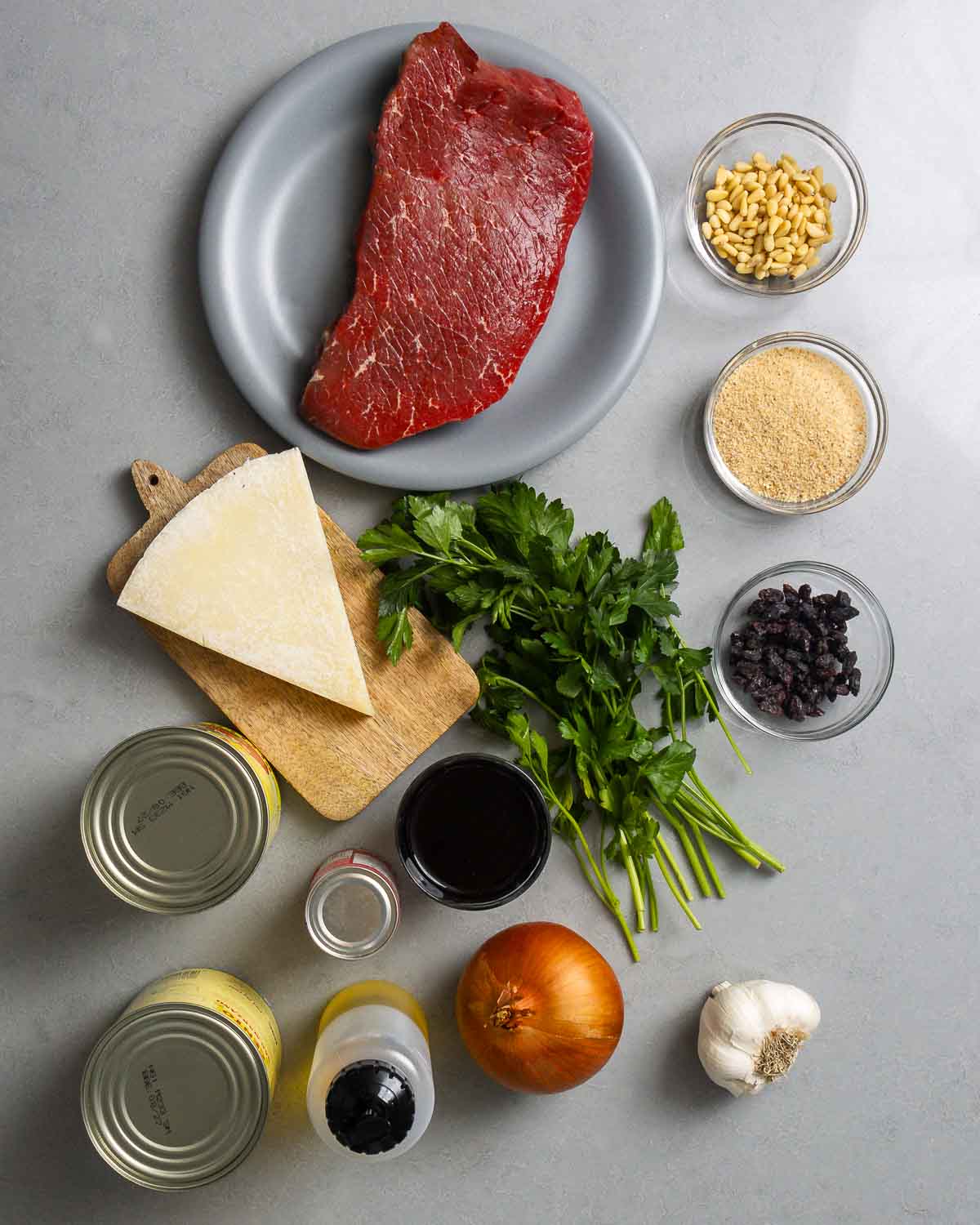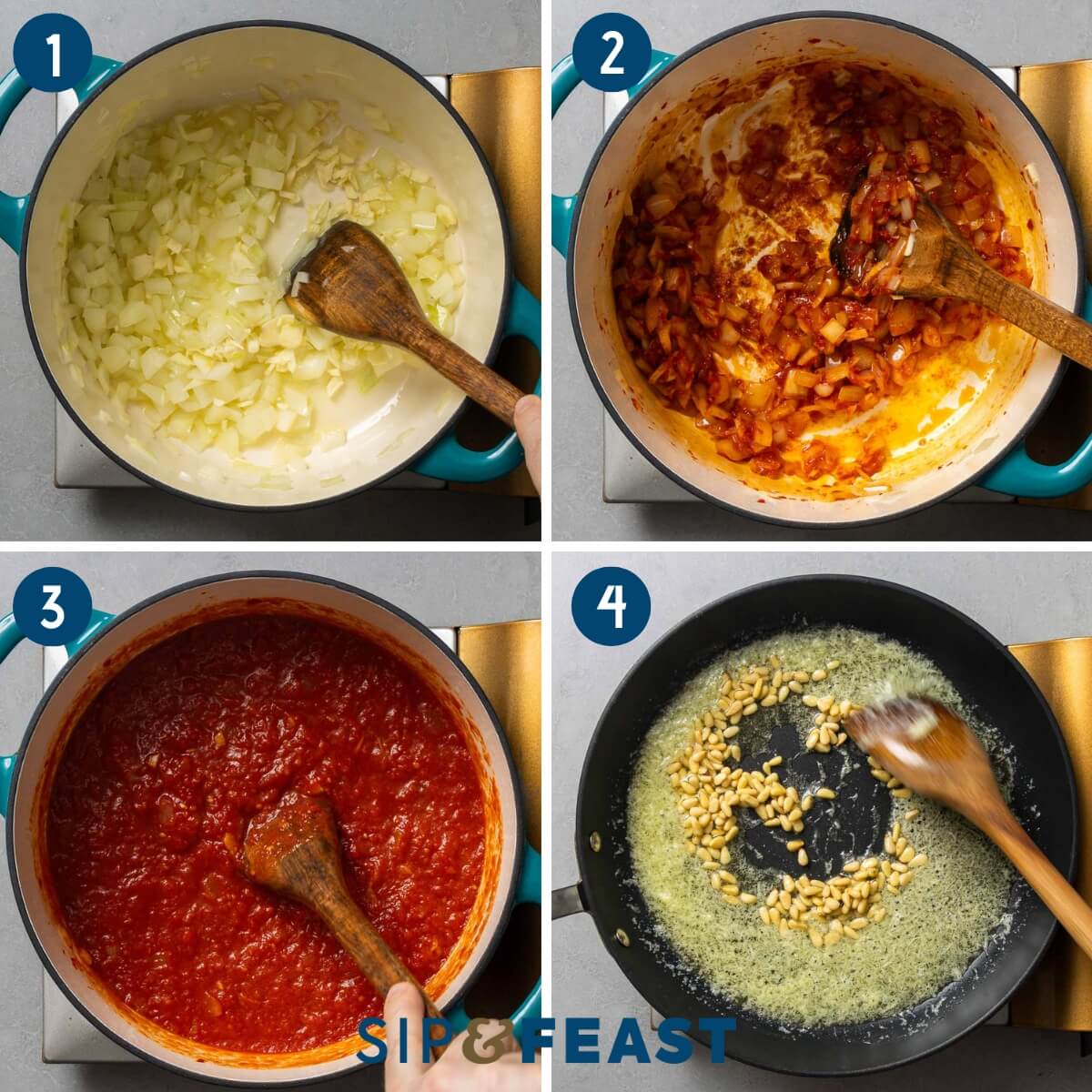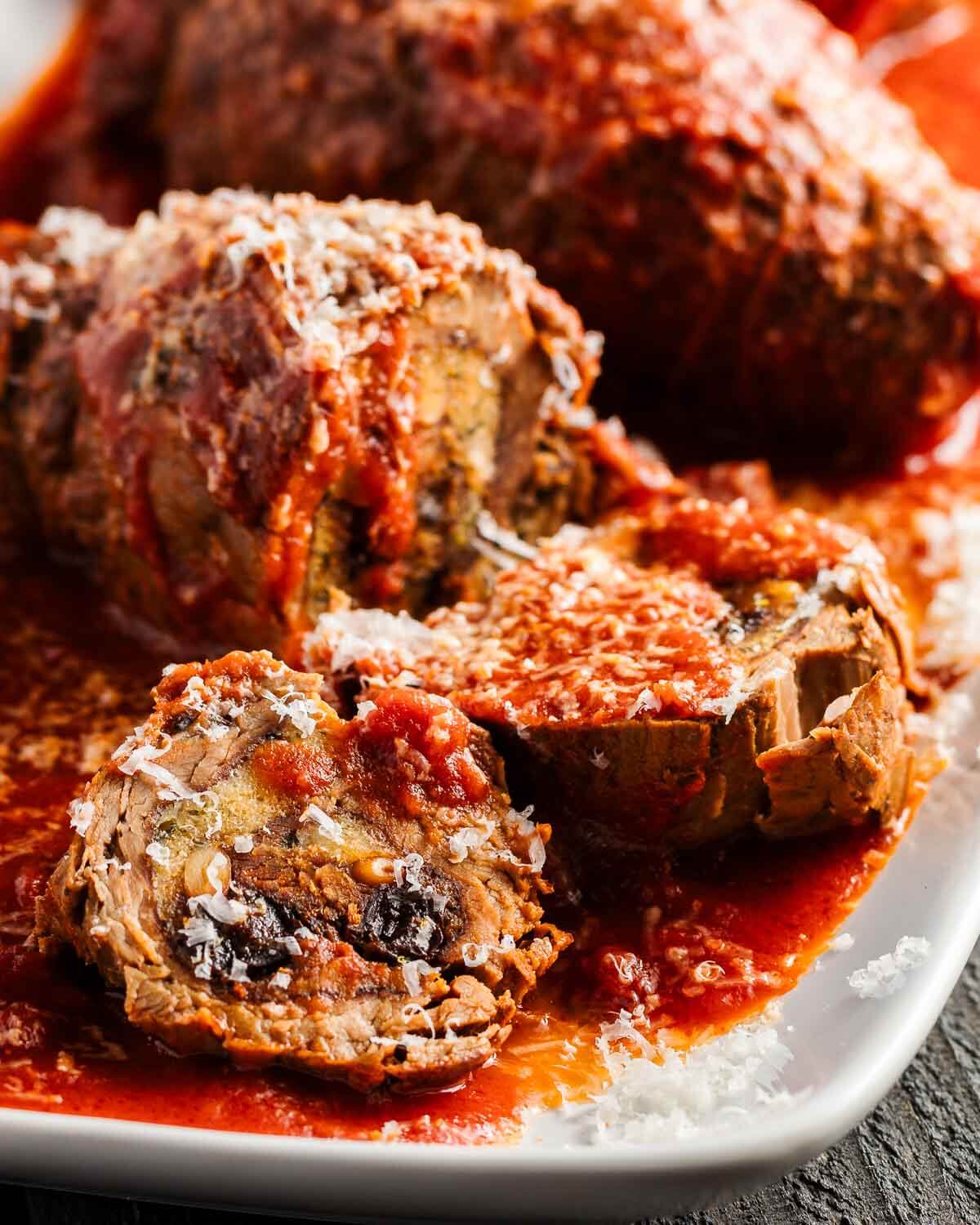There is no better addition to Sunday sauce than Beef Braciole! My version of this iconic Italian-American staple combines thinly sliced beef rolled and stuffed with breadcrumbs, pine nuts, cheese, and raisins and is braised in tomato sauce until tender.

Editor’s Note: Originally published on May 16, 2018. Updated with new photos and expanded information.
Most Italian-American families have their own beloved version of beef braciole.
Some use pork, some include hard-boiled egg yolks, and some are more Sicilian-influenced and use raisins and pignoli like I do.
I often include braciole in my Sunday sauce with meatballs and pork ribs served alongside pasta, garlic-sauteed broccoli rabe, and finished with a green salad.
Table of Contents
Recipe Ingredients
All ingredients for this recipe are shown in the pic below and special notes are made in this bulleted list to assist you.

- Beef. I prefer top round (often sold as London broil) for braciole. It’s inexpensive and works great. Depending on where you shop, you may be able to find thinly sliced top round that’s marked as “for braciole”, but if you need to filet a whole top round, I walk you through that process in the steps below.
- Breadcrumbs. For the stuffing. I used plain, but you can also use Italian-seasoned.
- Cheese. I prefer to use Pecorino Romano, a salty sheep’s milk cheese, in the beef braciole filling, but you can also use Parmigiano Reggiano, or domestic parmesan if you prefer.
- Pine nuts (pignoli) and raisins. These ingredients give a Sicilian twist to the braciole and are a winning flavor combination. Soak the raisins in water to reconstitute them.
- Tomatoes. 3 28-ounce cans of whole plum tomatoes (plus 2 ounces of tomato paste) will yield enough sauce for the braciole, plus 1 pound of pasta. You will have some extra sauce. That’s much better than not enough!
- Red wine. I always include a dry red wine, like a Sangiovese in my Sunday sauce, but you can omit it if you can’t have alcohol. I also use red wine to deglaze the pan, but this is optional (see steps 13 and 14 below).
See the recipe card for full information on ingredients and quantities.
How to make it
Each number corresponds to the numbered written steps below.
- Dice 1 medium onion and mince 5 cloves of garlic. Heat a large pot to a touch less than medium heat and add 1/4 cup of extra virgin olive oil and the onion and cook for 7-10 minutes or until soft. Then, add the garlic and cook for another 2 minutes or until fragrant. (Photo #1)
- Add 2 ounces of tomato paste and cook for 5 minutes, spreading the paste around with a wooden spoon. If the paste begins to burn, add a splash of water to bring the temperature down. (Photo #2)

- Add 1/2 cup of dry red wine and cook for 2 minutes while scraping the bottom of the pan to remove any brown bits, then add 3 28-ounce cans of plum tomatoes (hand-crushed or blender-pulsed) plus a 1/2 cup of water and bring to a simmer. Once simmering, cover with the lid slightly ajar and lower the heat to the lowest level. The sauce should be barely bubbling. (Photo #3)
- Soak a 1/4 cup of raisins in warm water for 10 minutes, then drain. Mince 3 cloves of garlic and use the back of your knife to turn it into a paste, then mince 1/2 cup of flat-leaf parsley. Grate 1/2 cup of Pecorino Romano cheese. Heat a small pan to medium heat and add 1/4 cup of extra virgin olive oil and the garlic paste. Once the garlic is lightly golden, add 1/4 cup of pine nuts and cook for 1-2 minutes. (Photo #4)
- Add 1 cup of breadcrumbs, the parsley, and the raisins and mix well until a paste is formed. Remove the pan from the heat, add the grated cheese, and set aside. (Photo #5)
- Take a 2-pound top round roast and filet to 1/2″ thick. (Photo #6)

- Cut the beef into 3×4″ rectangles. (Photo #7)
- Pound each rectangle to roughly 1/4″ thick which will make them substantially larger. (Photo #8)
- Arrange the pounded meat on a cutting board and season with salt and pepper. (Photo #9)
- Scoop an even amount of filling onto each piece of beef, then spread the filling out but leave 1/2 an inch or more around the edges. (Photo #10)

- Roll the meat tightly and secure with toothpicks or strings. Note that toothpicks will be much easier to remove later, while string will hold better. The choice is yours. (Photo #11)
- Heat a large pan to a touch less than medium, add 3 tablespoons of olive oil, and sear the braciole on all sides working in batches to not overcrowd the pan, then set aside. (Photo #12)
- If the pan isn’t burnt (brown is fine, black is not) drain or wipe away any excess fat and deglaze in the next step. If the pan is burnt you won’t want to deglaze and should skip to step 15. (Photo #13)
- Add the remaining 1/2 cup of dry red wine and scrape the brown bits with a flat-edged wooden spoon, then add the pan juices and wine to the pot of sauce and mix to incorporate. (Photo #14)

- Add the braciole to the sauce and cook on very low heat with the lid ajar for 2-3 hours or until fork-tender. Stir the sauce occasionally to prevent sticking. You can also choose to place the pot of sauce in the oven, covered, and cook for 2-3 hours at 300f. (Photo #15)
- If the sauce reduces too much while cooking, add a 1/2 cup of water or more as needed. Once tender, remove the braciole from the sauce and remove the twine or toothpicks, then taste test the sauce and adjust salt and pepper as needed. Serve with pasta, grated cheese, and crusty bread. Enjoy! (Photo #16)
Top tips
- Low and slow. Beef braciole is not something to be rushed. Because we’re using a tougher cut of meat, cooking it requires time to tenderize and break down the connective tissue. It’s best to start your braciole early in the day and allow it to cook in the sauce for several hours on a very low simmer.
- Deglazing the pan. After the braciole are seared I like to deglaze with some red wine, then add the mixture to the sauce. This enhances the flavor, but isn’t required and should only be done if the pan drippings are brown. If they’re black, they’re burnt and should not be added to the sauce.
- Serving with pasta. I purposely wrote this recipe to yield enough sauce to cook the braciole and to sufficiently sauce 1 pound of pasta. If you don’t plan to use pasta, you can save the leftover sauce and store in the fridge for 3-5 days, or freeze it for up to 3 months.

More Italian-American favorites
If you love beef braciole with Sunday sauce, here are a few more Italian-American red sauce meals I think you’ll enjoy!
- Steak pizzaiola – chuck steaks braised in a red wine tomato sauce with peppers and mushrooms.
- Chicken parmesan – breaded and fried cutlets baked with marinara and mozzarella.
- Italian meatloaf – with tomatoes and mushrooms.
If you’ve enjoyed this Beef Braciole Recipe or any recipe on this site, give it a 5-star rating and tell us about it in the comments below.
We strive to satisfy a number of learning styles. If you are someone who prefers to learn by watching, you can find most of our recipes on YouTube and our Facebook Page.
Beef Braciole

Ingredients
For the sauce
- 1/4 cup extra virgin olive oil
- 1 medium onion diced
- 5 cloves garlic minced
- 2 ounces tomato paste
- 1/2 cup dry red wine
- 3 28-ounce cans plum tomatoes hand crushed or blender pulsed
- salt and pepper to taste
- 1/2 cup water plus more if required to thin sauce
For the braciole
- 2 pounds top round
- 1/4 cup extra virgin olive oil
- 3 cloves garlic paste
- 1/2 cup flat-leaf Italian parsley minced
- 1 cup breadcrumbs
- 1/4 cup raisins or currants soaked in water then drained
- 1/4 cup pine nuts
- 3 tablespoons extra virgin olive oil
- 1/2 cup Pecorino Romano grated
- olive oil for shallow frying
- 1/2 cup dry red wine optional, see notes below
- salt and pepper to taste
Instructions
For the sauce
- Heat a large pot to a touch less than medium heat with the extra virgin olive oil. Add the onion and cook until soft (about 7-10 minutes) then add the garlic and cook for another 2 minutes or until fragrant.
- Add the tomato paste and cook for 5 minutes, spreading the paste around with a wooden spoon. If it starts to burn, add a few ounces of water.
- Add 1/2 cup of the wine and cook for 2 minutes while scraping the bottom of the pan to remove any brown bits.
- Add the plum tomatoes and water and bring to a simmer. Once simmering, cover with the lid left slightly ajar, and lower the heat to the lowest level so that the sauce is barely bubbling. You can season with a touch of salt right now, but it's best to wait since the sauce will reduce and concentrate.
For the braciole
- Heat a small pan to medium heat with the extra virgin olive oil and add the garlic. Once lightly golden, add the pine nuts and cook for 1-2 minutes until golden. Add the breadcrumbs, parsley, and raisins. Mix well until a paste forms. Remove the pan from the heat, mix in the Pecorino Romano, and set aside.
- Filet the top round to a 1/2" thick. Cut the beef into rectangles approximately 3×4 inches. Pound each rectangle to roughly a 1/4" thick which will make them substantially larger.
- Arrange the pounded meat on a cutting board and season the with salt and pepper. Leaving some space around the edges, evenly spread the paste onto each piece.
- You should have a thin layer of the mixture on each piece of meat. Roll each piece tightly and secure them with toothpicks or kitchen twine.
- Heat a large pan to a touch less than medium heat with olive oil. Sear the pieces on all sides, working in batches if required to not overcrowd the pan.
- After the braciole are seared, add each one to the pot of sauce. If the pan isn't burnt, pour off the fat from the pan and deglaze with the remaining 1/2 cup of dry red wine. Scrape the brown bits off the bottom of the pan. Pour the pan juices into the pot of sauce and mix to incorporate.
- Cook for 2-3 hours, or until fork tender, on very low heat with the lid left slightly ajar, making sure to stir the sauce occasionally. If the sauce dries out during the cooking process, add a 1/2 cup of water or more as needed. Alternative method: Cover the pot and place it in the center of the oven at 300f for 2-3 hours or until tender.
- Once tender, remove the braciole from the sauce and cut away the twine or remove the toothpicks. Taste the sauce and season with salt and pepper. Serve with pasta, grated cheese, and crusty bread. Enjoy!
Notes
- Besides top round, bottom round, eye of round, flank steak, or sirloin can be used. They should all be pounded flat to 1/4″ thick for easy rolling.
- Kitchen twine will hold more securely, but toothpicks work well and are far easier to remove.
- If the pan is burnt (very black) after searing the braciole, forgo deglazing the pan. If you want to try it anyway, simply deglaze and taste the mixture, checking for a burnt flavor, before adding it to the sauce.
- Leftovers can be stored in the fridge for up to 3 days. It will taste even better the next day. Just reheat on a stovetop until completely heated through. Freeze for up to 3 months.
Nutrition
Nutrition information is automatically calculated, so should only be used as an approximation.
This recipe was originally published on May 16, 2018. It was fully updated with new photos, process shots, and text on January 26, 2024.







Hello, James—
Love your recipes and tips for making delicious meals. Typically I read your recipes each week, print them and keep them in a 3-ring binder for repeated use, which brings me to my question. Have you ever written a cookbook or have any plans to do so? I, for one, would love to have one on my shelf for easy reference when deciding on what to make. Just a thought.
Thank you for all of the help and information. Please keep the recipes coming!
Hi Anthony, thanks for the comment and we’re so happy you’re enjoying the recipes. We are in the process of working on a cookbook but don’t have a release date or anything just yet. We’ll be sure to communicate here on the website, email, YouTube, our podcast, etc. as we have more information to share.
Omg I’ve been wanting to ask for so long if you guys are going to get a cookbook together and here it is somebody else’s thinking the same you guys are awesome. Make sure you put out there when you do have a cookbook because it’ll sold out before you can even snap your fingers. Thank you so much. I hope you guys are doing wonderful. Much blessings to you always
Hi Kathie, thanks for the comment and we’ll be sure to communicate cookbook news here on our website, YouTube, and via email!
I usually add a slice of provolone and prosciutto de parma on top of the meat before adding the breadcrumb/parsley/pine nut/raisin paste mix. Also, last time I made this I used your bread and ricotta method for tender meatballs to make the paste and it turned out fantastic! I just cut back on the ricotta to about 1/2 a cup to 4 slices of bread, and then mixed the parsley, garlic, pine nuts and raisins in.
I’m definitely going to use your method for toasting the pine nuts in garlic. That looks great!
I am so happy you posted the bracciole recipe! I’m going to make it this weekend! Keep sharing all you know…..
This looks amazingly delicious! I will be making it! You think that once the rolls and the sauce is done, you can cook it in a slow cooker? What is the name of that pasta? Haven’t seen it it the store and will probably need to order online. THANKS!
Hi Jo, these should be fine to make in a slow cooker. The pasta in the photos is paccheri but you can use any shape you’d like. Rigatoni would be close, just smaller.
James your recipes are fantastic.
Hi! I really want to make this for Christmas Eve. Can I prepare the day before and then cook the next day?
Hi Rebecca, yes, you can prep these the day before and cook on Christmas Eve. Hope you enjoy!
I live here on Long Island Bluepoint.I could watch you all day
Hey Russ, thanks for the comment and so happy you’re enjoying the recipes and videos!